
DavidBowieWorld.nl

David Bowie 1983 Serious Moonlight Tour
David Bowie on stage during the 1983 Serious Moonlight Tour Tour by David Bowie Associated album Let’s Dance Start date 18 May 1983 End date 8 December 1983 Legs 8 Shows 96
The David Bowie Serious Moonlight Tour was thus far Bowie’s longest, largest and most successful concert tour. The tour opened at the Vorst Forest Nationaal, Brussels, on 18 May 1983 and ended in the Hong Kong Coliseum on 8 December 1983; 16 countries visited, 96 performances, and over 2.6M tickets sold. The tour garnered mostly favorable reviews from the press.
Tour development Bowie himself had a hand in the set design for the tour, which included giant columns (affectionately referred to as “condoms”) as well as a large moon and a giant hand. Some of the musicians from his 1978 tour were re-hired for this tour, including Carlos Alomar, who was the band leader for the tour. Earl Slick was drafted as guitarist a few days before the commencement of the tour due to problems with Stevie Ray Vaughan’s management demanding a contract renegotiation. The band rehearsed for the tour in Dallas, Texas. Each band member wore a costume which was designed “down to the smallest detail.” Two sets of each person’s costumes were made and worn on alternate nights, and everyone got to keep one set at the conclusion of the tour as a souvenir. One song that was on the rehearsal’s song list that never actually got to the rehearsal stage was “Across the Universe,” which Bowie had covered in 1975 on his Young Americans album.
Tour performances Earl Slick November 1983 during the Serious Moonlight Tour On 30 June 1983 the performance at the Hammersmith Odeon in London was a charity show for the Brixton Neighbourhood Community Association in the presence of Princess Michael of Kent. The 13 July 1983 Montreal Forum performance was recorded and broadcast on American FM Radio and other radio stations worldwide. The concert on 12 September in Vancouver was recorded for the concert video Serious Moonlight, that was released in 1984 and on DVD in 2006. At the Canadian National Exhibition Stadium – Toronto, ON performance on 4 September 1983, Bowie introduced onstage special guest, Mick Ronson, who borrowed Earl Slick’s guitar and performed “The Jean Genie” with Bowie and band. Mick had only been asked to play the day before, and he later recalled: I was playing Slick’s guitar … I had heard Slick play solos all night so I decided not to play solos and I just went out and thrashed the guitar. I really thrashed the guitar, I was waving the guitar above my head and all sorts of things. It was funny afterwards because David said, ‘You should have seen [Earl Slick’s] face…’ meaning he looked petrified. I had his prize guitar and I was swinging it around my head and Slick’s going ‘Waaaa… watch my guitar’, you know. I was banging into it and it was going round my head. Poor Slick. I mean, I didn’t know it was his special guitar, I just thought it was a guitar, a lump of wood with six strings. The last show of the tour (8 December 1983) was the third anniversary of John Lennon’s death, whom both Bowie and Earl Slick had worked with in the studio previously. Slick suggested to Bowie a few days prior to the show that they play “Across the Universe” as a tribute, but Bowie said, “Well if we’re going to do it, we might as well do “Imagine.”” They rehearsed the song a couple of times on 5 December (in Bangkok) and then performed the song on the final night of the tour as a tribute to their friend.
Tour legacy The tour was a high point of commercial success for Bowie, who found his new popularity perplexing. Bowie would later remark that with the success of Let’s Dance and the Serious Moonlight Tour, he had lost track of who his fans were or what they wanted.[5] One critic would later call this tour his “most accessible” because “it had few props and one costume change, from peach suit to blue.” Bowie later specifically tried to avoid repeating the formula for success from his Serious Moonlight Tour with his 1987 Glass Spider Tour.
Tour band David Bowie – vocals, guitar, saxophone Earl Slick – guitar Carlos Alomar – guitar Carmine Rojas – bass guitar Tony Thompson – drums, percussion Dave Lebolt – keyboards, synthesizers Steve Elson – saxophones Stan Harrison – saxophones, woodwinds Lenny Pickett – saxophones, woodwinds George Simms – backing vocals Frank Simms – backing vocals
Date City Country Venue
Europe 18 May 1983 Brussels ,Belgium ,Vorst Forest Nationaal 19 May 1983 Brussels ,Belgium ,Vorst Forest Nationaal 20 May 1983 FrankfurtWest GermanyFesthalle 21 May 1983 Munich ,Olympiahalle 22 May 1983 Munich ,Olympiahalle 24 May 1983 Lyon ,France ,Palais des Sports de Gerland 25 May 1983 Lyon ,France ,Palais des Sports de Gerland 26 May 1983 Fréjus ,Les Arènes 27 May 1983 Fréjus ,Les Arènes 29 May 1983 Nantes (Cancelled) Le Beaujoire
North America 30 May 1983 San Bernardino, California ,US Festival Glen Helen Regional Park
Europe 02 June 1983 London, England ,Wembley Arena 03 June 1983 London ,England ,Wembley Arena 04 June 1983 London ,England ,Wembley Arena 05 June 1983 Birmingham ,National Exhibition Centre 06 June 1983 Birmingham ,National Exhibition Centre 08 June 1983 Paris ,France ,Hippodrome D’Auteuil 09 June 1983 Paris ,France ,Hippodrome D’Auteuil 11 June 1983 Gothenburg ,Sweden ,Ullevi Stadium 12 June 1983 Gothenburg ,Sweden ,Ullevi Stadium 15 June 1983 Bochum ,Germany ,Ruhrstadion 17 June 1983 Bad Segeberg ,Freilichtbühne 18 June 1983 Bad Segeberg ,Freilichtbühne 20 June 1983 Berlin ,Waldbühne 24 June 1983 Offenbach am Main ,Bieberer Berg Stadion 25 June 1983 Rotterdam ,Netherlands ,Stadion Feijenoord 26 June 1983 Rotterdam ,Netherlands ,Stadion Feijenoord 28 June 1983 Edinburgh ,Scotland ,Murrayfield Stadium 30 June 1983 London ,England ,Hammersmith Odeon 01 July 1983 Milton Keynes ,Milton Keynes Bowl 02 July 1983 Milton Keynes ,Milton Keynes Bowl 03 July 1983 Milton Keynes ,Milton Keynes Bowl
North America 11 July 1983 Quebec City, Quebec ,Canada ,Colisée de Québec 12 July 1983 Montreal, Quebec ,Montreal Forum 13 July 1983 Montreal, Quebec ,Montreal Forum 15 July 1983 Hartford, Connecticut ,US ,Hartford Civic Center 16 July 1983 Hartford, Connecticut ,US ,Hartford Civic Center 18 July 1983 Philadelphia, Pennsylvania ,The Spectrum 19 July 1983 Philadelphia, Pennsylvania ,The Spectrum 20 July 1983 Philadelphia, Pennsylvania ,The Spectrum 21 July 1983 Philadelphia, Pennsylvania ,The Spectrum 23 July 1983 Syracuse, New York (Re-scheduled) – Carrier Dome 25 July 1983 New York City ,Madison Square Garden 26 July 1983 New York City ,Madison Square Garden 27 July 1983 New York City ,Madison Square Garden 29 July 1983 Richfield, Ohio ,Richfield Coliseum 30 July 1983 Detroit, Michigan ,Joe Louis Arena 31 July 1983 Detroit, Michigan ,Joe Louis Arena 01 August 1983 Rosemont, Illinois ,Rosemont Horizon 02 August 1983 Rosemont, Illinois ,Rosemont Horizon 03 August 1983 Rosemont, Illinois ,Rosemont Horizon 07 August 1983 Edmonton, Alberta ,Canada ,Commonwealth Stadium 09 August 1983 Vancouver, British Columbia ,Pacific Colesium 11 August 1983 Tacoma, Washington ,United States ,Tacoma Dome 14 August 1983 Los Angeles, California ,The Forum 15 August 1983 Los Angeles, California ,The Forum 17 August 1983 Phoenix, Arizona ,Veterans Memorial Coliseum 19 August 1983 Dallas, Texas ,Reunion Arena 20 August 1983 Austin, Texas ,Frank Erwin Center 21 August 1983 Houston, Texas ,The Summit 24 August 1983 Norfolk,Virginia,Scope Cultural & Convention Center 25 August 1983 Norfolk,Virginia,Scope Cultural & Convention Center 27 August 1983 Landover, Maryland ,Capital Centre 28 August 1983 Landover, Maryland ,Capital Centre 29 August 1983 Hershey, Pennsylvania ,Hersheypark Stadium 31 August 1983 Foxborough, Massachusetts ,Sullivan Stadium 03 September 1983 Toronto, OntarioCanada ,National Exhibition Stadium 04 September 1983 Toronto, Ontario ,Canada ,National Exhibition Stadium 05 September 1983 Buffalo, New YorkUnited StatesBuffalo Memorial Auditorium 06 September 1983 Syracuse, New York ,Carrier Dome 09 September 1983 Anaheim, California ,Anaheim Stadium 11 September 1983 Vancouver, British Columbia ,CanadaPacific National Exhibition Coliseum 12 September 1983 Vancouver, British Columbia ,CanadaPacific National Exhibition Coliseum 14 September 1983 Winnipeg, Manitoba ,Winnipeg Stadium 17 September 1983 Oakland, California ,Oakland Alameda Coliseum
Asia 20 October 1983 Tokyo ,Japan ,Nippon Budokan 21 October 1983 Tokyo ,Japan ,Nippon Budokan 22 October 1983 Tokyo ,Japan ,Nippon Budokan 24 October 1983 Tokyo ,Japan ,Nippon Budokan 25 October 1983 Yokohama ,Yokohama Stadium 26 October 1983 Osaka ,Osaka Prefectural Gymnasium 27 October 1983 Osaka ,Osaka Prefectural Gymnasium 29 October 1983 Nagoya ,Kokusai Tenji Kaikan 30 October 198 3 Osaka ,Expo Commemoration Park 31 October 1983 Kyoto ,Kyoto Prefectural Gymnasium
Oceania 04 November 1983 Perth ,Australia ,Perth Entertainment Centre 05 November 1983 Perth ,Australia ,Perth Entertainment Centre 06 November 1983 Perth ,Australia ,Perth Entertainment Centre 09 November 1983 Adelaide ,Adelaide Oval 12 November 1983 Melbourne ,VFL Park 16 November 1983 Brisbane ,Lang Park 1 9 November 1983 Sydney ,RAS Showgrounds 20 November 1983 Sydney ,RAS Showgrounds 24 November 1983 Wellington ,New Zealand ,Athletic Park 26 November 1983 Auckland ,Western Springs Stadium
Asia 03 December 1983 Kallang ,Singapore ,National Stadium 05 December 1983 Bangkok ,Thailand ,Thai Army Sports Stadium 07 December 1983 Hung Hom, Kowloon ,Hong KongHong Kong Coliseum 08 December 1983 Hung Hom, Kowloon ,Hong Kong Coliseum
The Songs From Space Oddity “Space Oddity” From Hunky Dory “Life on Mars?” From The Rise and Fall of Ziggy Stardust and the Spiders from Mars “Soul Love” “Star” “Hang on to Yourself” From Aladdin Sane “Cracked Actor” “The Jean Genie” From Pin Ups “I Can’t Explain” (originally non-album single by The Who, written by Pete Townshend) “Sorrow” (originally by The McCoys, written by Bob Feldman, Jerry Goldstein and Richard Gottehrer) From Diamond Dogs “Rebel Rebel” From Young Americans “Young Americans” “Fame” (Bowie, John Lennon, Carlos Alomar) From Station to Station “Station to Station” “Golden Years” “TVC 15” “Stay” “Wild Is the Wind” (originally a single by Johnny Mathis, written by Dimitri Tiomkin and Ned Washington) From Low “Breaking Glass” (Bowie, Dennis Davis, George Murray) “What in the World” From “Heroes” “Joe the Lion” “”Heroes”” (Bowie, Brian Eno) From Lodger “Red Sails” (Bowie, Eno) “Look Back in Anger” (Bowie, Eno) From Scary Monsters (and Super Creeps) “Scary Monsters (and Super Creeps)” “Ashes to Ashes” “Fashion” From Let’s Dance “Modern Love” “China Girl” (originally from The Idiot by Iggy Pop, written by Pop and Bowie) “Let’s Dance” “Cat People (Putting Out Fire)” (originally from Cat People: Original Soundtrack, written by Bowie and Giorgio Moroder) Other songs: “Imagine” (originally from Imagine by John Lennon, written by Lennon) “White Light/White Heat” (from White Light/White Heat by The Velvet Underground, written
8 thoughts on “David Bowie 1983 Serious Moonlight Tour”
- Pingback: Channeling David Bowie’s Light Into ‘Moonage Daydream’ | WORLD NEWSPOT
- Pingback: Channeling David Bowie’s Light into Moonage Daydream | Insta noti
To this day this was the best concert I’ve ever been to. David always loved playing in Philadelphia and that’s where I seen him. I’ve been to well over a 100 concerts over 45 years . No one has the stage presence of David Bowie.
A memorable concert in Munich
I was at the Washington DC Event in August 1983. Six of my friends went in tux’s and a limo. I remember they kick a 14 foot inflated world ball into the crowd and it made its way around the whole stadium.
Great memories!!!
I remember i couldn’t get a ticket for England, so got a ticket for the 25th of june in Rotherdam, fond memories had to take a train to London, then coach to Rotterdam, stayed in nice hotel, brilliant time.
I saw the September 5 concert in Buffalo. It was a thrill to see him and a great spectacle. He came out as the Thin White Duke at one point–very theatrical. I wish I could remember who opened that show.
Was at the Sept 9 gig and was looking for the opening band’s lineup, I know the Go Go’s and Madness opened but my memory fails the rest, I will say a guy was hit and killed by a train of all thing’s on his way to the concert, kinda sad. But, what was worse was the radio station KROQ in Los Angeles played Ozzy’s Crazy Train all the next day because of it…and they didn’t play rock and roll..good times ✌🧡
Leave a comment
- Manage Account
When David Bowie Met Stevie Ray Vaughan: Collaborators Look Back on the Brief Pairing
It’s strange when you realize one of your favorite recording artists sessioned on the hit album of another one of your favorite acts back in the day. And for some, it might be a surprise to…
By Ron Hart
- Share this article on Facebook
- Share this article on Twitter
- Share this article on Flipboard
- Share this article on Pinit
- + additional share options added
- Share this article on Reddit
- Share this article on Linkedin
- Share this article on Whatsapp
- Share this article on Email
- Print this article
- Share this article on Comment
- Share this article on Tumblr

It’s strange when you realize one of your favorite recording artists sessioned on the hit album of another one of your favorite acts back in the day. And for some, it might be a surprise to learn that the late blues giant Stevie Ray Vaughan served as the lead guitarist on David Bowie’s 1983 smash LP Let’s Dance .
“It was just a trip to hear my kid brother on a No. 1 record [the title track topped the Billboard Hot 100 in May ’83],” says guitarist Jimmie Vaughan, who would go on to work with his sibling and Let’s Dance producer Nile Rodgers on the 1990 LP Family Style as The Vaughan Brothers. “That song just took over everything; a total smash. And there was Stevie playing lead guitar on it. Stevie called me to tell me he had met up with David Bowie and Nile Rodgers in New York, and I think they recorded him pretty quickly. It was only one day or something for the guitar; he just overdubbed himself onto the tracks. But he only needed one or two takes; he just went in there all fired up and did his thing.”
The dialogue that we were always supposed to follow — put forth by music critics and even Bowie himself — was how the dearly departed Duke’s mid-80s albums were to be avoided at all costs. And while people were largely talking about 1984’s Tonight and 1987’s Never Let Me Down , unfortunately Let’s Dance was also swept up onto the blacklist by some fans despite its largely positive critical acclaim upon hitting record shops in April of ’83. Thanks to the fourth edition of Parlophone’s Bowie box set series, however, Bowie’s Labyrinth era has been given a long-overdue reassessment, including a complete makeover of the largely reviled Never Let Me Down by one of the singer’s closest studio associates in producer Mario McNulty.
Trending on Billboard
“Both Bowie and Stevie Ray Vaughan were mega monster musicians,” McNulty tells Billboard. “And the stuff they did on Let’s Dance was made to stand the test of time. It’s pretty amazing. David was the best at bringing together the likes of Stevie Ray Vaughan and Nile Rodgers in a room.”
When unboxing Loving the Alien and digging into this period, one cannot help but be reminded of the trinity that gave the former Mr. Stardust his biggest smash and the potential of what could have been had Vaughan not decided to back away from touring with Bowie, so ebulliently displayed on the famous bootleg 1983 Dallas . Listening to the Austin guitar icon melt into songs and styles you’d never expect him to, like “Station to Station,” “TVC 15” and “Life On Mars,” gives you a prominent display of the versatility that would define the guitarist and his all-too-brief career as the purveyor of raw electric blues purity in the 1980s. It’s highly surprising, in fact, to reckon that Vaughan—though an admirer of Bowie—was not entirely hip to his whole catalog despite the ease by which he played alongside such longtime David cohorts as bassist Carmine Rojas and guitarists Earl Slick and Carlos Alomar, who also served as the music director of the Serious Moonlight tour in support of Let’s Dance.
“To tell you the truth, I was not very familiar with David’s music when he asked me to play on the sessions,” Vaughan said in conversation with late Billboard editor in chief Timothy White for an interview in the May 1983 issue of Musician . “David and I talked for hours and hours about our (Double Trouble’s) music, about funky Texas blues and its roots – I was amazed at how interested he was. At Montreux, he said something about being in touch and then tracked me down in California, months and months later.”
Indeed, Vaughan and Double Trouble — the inimitable rhythm section of Tommy Shannon on bass and drummer Chris Layton — were booed by some blues purists during their breakout performance at the 1982 Montreux Jazz Festival, but the band gained a big fan in Bowie, who not only talked to Stevie that night, but Layton as well.
David Bowie's Top 20 Biggest Billboard Hits
“He wanted to know where Stevie grew up,” Layton tells Billboard. “How did we all meet, where me and Tommy were from, how did we all begin the band. He was giving due diligence to finding everything out that connected us. He seemed to be trying to realize the idea that Stevie would work on Let’s Dance, and that we’d all go on tour together; kinda testing the waters of what he could do with the whole concept involving himself and Stevie. Unfortunately, none of the other came to pass beyond Stevie playing on Let’s Dance and going to rehearse the tour with him in Dallas, which we know he didn’t do.”
Though Vaughan did set Bowie’s setlist on fire with his ferocious playing in Dallas, it was clear that level of touring life was the wrong route for him to embark upon the precipice of his own rising star as Double Trouble’s classic debut Texas Flood was about to see worldwide release on June 13, 1983. In fact, it was Alomar who admits to helping Vaughan reach a decision that some reports had also blamed on the Austin guitarist’s hard partying ways.
“There’s always that place where a musician comes to a superstar situation and thinks this might be a launching pad, this might be the door that I’ve been looking for,” Alomar explains to Billboard. “When I met Stevie, it was about saying to him, ‘Dude, what are you doing? Nobody has founded their career from this.’ You gotta remember that somebody’s first record…man, that’s their heart. They’ve been living with those songs for years, which made Texas Flood so special. It was kismet. He had to deny David. He wasn’t supposed to be there, man. He was supposed to be promoting his debut, going out there and killing it, playing all night long and then getting in the car and driving to the next gig. Not jet planes and sushi chefs. I think that would have jaded his blues-ness. Stevie was the real deal, and he wasn’t going to let anyone take that away from him.”
In turn, Vaughan closed out his 1983 by jamming with his lifelong hero Albert King on the show In Session on the Hamilton, Ontario, public television station CHCH. King had known Vaughan as “Little Stevie,” the skinny white kid who used to come around and sit in whenever Albert passed through Austin for gigs. To hear him tell the story on this show is both hilarious and heartwarming. What would transpire over the course of the next hour and 45 minutes is one of the most special unions of teacher and student in modern music history. “I’m about ready to turn it over to you,” King says to Vaughan at one point during the taping. “No, I don’t believe that,” Stevie responded. “Oh yes, it’s true son, it’s true,” he returned. “Twenty-eight years is long enough. I gotta sit back and watch you.”
It was a moment that might not have happened had Vaughan not heeded Alomar’s advice. The guitarist and Double Trouble would go on to produce three more studio albums of modern AOR blues with 1984’s Couldn’t Stand the Weather , 1985’s Soul to Soul and 1989’s In Step before we lost Vaughan in a helicopter crash in East Troy, WI, on Aug. 27, 1990. He was just 35. However, in revisiting this particular period in the careers of Bowie and Vaughan through the Loving the Alien box set, we can be incredibly grateful that he chose self over stardom in his decision to make his residence in the Ziggy Universe a brief one, albeit one that helped launch him into the stratosphere of acclaim among music fans, heroes and peers alike.
“Stevie had a major amount of respect for David and vice versa,” Layton explains to Billboard. “But sometimes things just don’t work out, and Stevie didn’t know if he could give his full commitment at the time. We were all trying to do the things we wanted to do back then, and we all move in and out of different spheres for every season. But Bowie saw us play and was so fascinated by Stevie he wanted to figure out how he could work him into what he was doing. I give Bowie so much credit for reading between the lines in our culture and sense something that might not have been as obvious to the naked eye.”
Get weekly rundowns straight to your inbox
Want to know what everyone in the music business is talking about?
Get in the know on.
Billboard is a part of Penske Media Corporation. © 2024 Billboard Media, LLC. All Rights Reserved.
optional screen reader
Charts expand charts menu.
- Billboard Hot 100™
- Billboard 200™
- Hits Of The World™
- TikTok Billboard Top 50
- Song Breaker
- Year-End Charts
- Decade-End Charts
Music Expand music menu
- R&B/Hip-Hop
Culture Expand culture menu
Media expand media menu, business expand business menu.
- Business News
- Record Labels
- View All Pro
Pro Tools Expand pro-tools menu
- Songwriters & Producers
- Artist Index
- Royalty Calculator
- Market Watch
- Industry Events Calendar
Billboard Español Expand billboard-espanol menu
- Cultura y Entretenimiento
Honda Music Expand honda-music menu
Memories of David Bowie in concert at the Milton Keynes Bowl
- Monday 11 January 2016 at 1:10pm
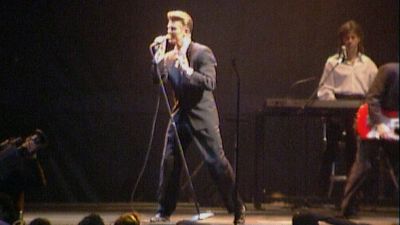
It was a hot summer's day back in 1990 that a crowd of 60,000 gathered at the Milton Keynes Bowl to watch David Bowie in concert.
As temperatures soared fans were treated for dehydration, sun burn and heat exhaustion.
It was the second time that David Bowie has played Milton Keynes.
It was billed as a farewell as Bowie said it would be the last time he would perform his hit songs of the past three decades.
The concert was also attend by fellow musicians Dave Stewart of The Eurythmics and Siobhan Fahey of Bananarama and Shakespeare's Sister.
Click below to watch the Anglia Television archive report from August 1990 by reporter Sue Kinnear
News & Views

David Bowie’s Electric Night at the Milton Keynes Bowl in 1983
Milton Keynes, England – In an electrifying performance that left thousands of fans spellbound, legendary musician David Bowie took to the stage at the Milton Keynes Bowl on a balmy summer night, delivering a show that would be etched into the memories of all fortunate enough to witness it.
The year was 1983, and Bowie was riding the wave of his critically acclaimed album, “Let’s Dance,” which had catapulted him back into the mainstream music scene. The Milton Keynes Bowl, known for its capacity to host large-scale events, was chosen as the venue for Bowie’s highly anticipated performance on July 30.
As the sun began to set, the anticipation among the crowd was palpable. Fans of all ages, clad in vibrant attire, eagerly awaited the appearance of the iconic artist. The atmosphere crackled with excitement and a shared sense of anticipation as the opening act, Big Country, concluded their set, setting the stage for Bowie’s grand entrance.
At precisely 8:30 p.m., the lights dimmed, and the stage came alive with an explosion of sound and light. Bowie emerged, resplendent in a sleek, monochromatic suit, his unmistakable charisma radiating from every pore. The crowd erupted into thunderous applause and cheers, unable to contain their excitement.

The setlist was a carefully curated journey through Bowie’s discography, combining his greatest hits with new tracks that showcased his evolving musical style. From the pulsating rhythms of “Modern Love” to the ethereal beauty of “Space Oddity,” Bowie’s ability to captivate and enthrall was unparalleled.
But it was the moment when Bowie launched into the title track, “Let’s Dance,” that the Milton Keynes Bowl was transformed into a pulsating sea of movement and euphoria. The infectious beats and Bowie’s commanding stage presence invited the crowd to join in a collective celebration of life, love, and the power of music. It was a magical experience that forged an unbreakable connection between artist and audience.
Throughout the performance, Bowie’s theatricality and magnetic stage presence were complemented by a dazzling light show, innovative choreography, and a tight-knit band that perfectly translated his vision into a sensory feast for the audience. The seamless blend of rock, pop, and funk sent waves of energy cascading through the crowd, inspiring spontaneous sing-alongs and dance parties.
Bowie’s concert wasn’t just about the music; it was a multi-sensory experience that challenged boundaries and defied expectations. From his chameleon-like fashion choices to his dramatic vocal delivery, Bowie’s performance was a testament to his enduring artistic genius.

As the night drew to a close, Bowie bid farewell to the Milton Keynes Bowl with an encore that left the crowd yearning for more. The anthemic “Heroes” echoed through the air, its lyrics resonating with the hearts of all in attendance, reminding them of the power of individuality and self-expression.
As the final notes faded into the night, the audience erupted into a deafening roar of appreciation and awe. The memories of that summer evening would remain etched in their minds forever, a testament to the timelessness of David Bowie’s music and the impact he had on countless lives.
As the crowd dispersed, awestruck fans could be heard sharing their favorite moments and recounting the magic they had witnessed. Bowie’s performance at the Milton Keynes Bowl in 1983 had cemented his status as an unrivaled musical icon and left an indelible mark on the cultural fabric of the time.
Decades later, the echoes of that unforgettable night continue to resonate, reminding us that David Bowie’s
Share this:
Leave a reply cancel reply, discover more from chronology.
Subscribe now to keep reading and get access to the full archive.
Type your email…
Continue reading
- International edition
- Australia edition
- Europe edition
50 David Bowie moments
From suburban London schoolboy to a musical colossus, snapshots of David Bowie’s kaleidoscopic life
1 He was born David Robert Jones on 8 January 1947 in Brixton, south London, the son of Margaret, a waitress, and Haywood Stenton Jones, a former nightclub impresario then running a Dr Barnardo’s children’s home.
2 Fittingly, Bowie shared his birthday with Elvis Presley , Gypsy Rose Lee, the occult novelist Dennis Wheatley, William Hartnell (the first Doctor Who) and the Bowie-like figure of Roy Batty, the post-human “replicant” android of Blade Runner, whose “incept date” of 8 January 2016 was at the very least an intriguing coincidence.
3 The Jones family moved to the suburbs of Bromley, on the London-Kent border, in 1953 where young David acquired a reputation for “vividly artistic” dancing. He went to Bromley technical school.
4 The artist who transformed pop into a futurist sci-fi proposition in the 1970s was as much a child of traditional rock’n’roll as the Beatles. After hearing Tutti Frutti by his lifelong hero Little Richard in 1955, he recalled: “I had heard God.” Aged 15 and now owning a plastic alto saxophone, Jones decided he wanted to make a career in music.
5 David Jones acquired his famous eyes in 1962 when his best friend, George Underwood, punched him during a fracas over a girl. The injury permanently paralysed the muscles in his left iris, creating the illusion of heterochromia or different coloured irises. Jones later thanked the mortified Underwood for “giving him mystique”.
6 Owen Frampton, Bowie’s head of art at Bromley Tech, was the father of Peter Frampton, who played guitar on Bowie’s poorly received Glass Spider tour in 1987.
7 Though eventually one of the most influential artists in music and beyond, Davy Jones, as he was by now, spent most of the 1960s frustratingly chasing trends, enduring a succession of false starts, first with blues-influenced bands such as the Kon-rads, the Manish Boys and the Lower Third, and then as a solo artist.
8 At one point he considered leaving music altogether to study mime at Sadler’s Wells.
9 The failure of his eponymous debut album – a “Swinging London” affair that mixed pop, music hall and psychedelia – and its novelty single The Laughing Gnome in 1967 – prompted the newly renamed David Bowie to follow art rather than populism. Enrolling in Lindsay Kemp’s London Dance Centre, he began to explore mime, commedia dell’arte and his sexuality (the two were probably lovers). When Bowie returned to music in 1969 it was as an avant-garde folk flower child.
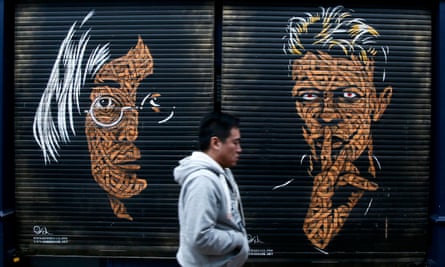
10 Though partially written to chime with the first Moon landing, Bowie’s 1969 debut hit, Space Oddity, contains all the themes of Bowie’s future work: alienation, resignation, romantic futurism, cosmic dread and, of course, the recurring figure of Major Tom. This spaced-out spaceman and crucified media victim was possibly named, according to the Bowie scholar Nicholas Pegg, after Brixton music hall regular Tom Major – the father of future prime minister John.
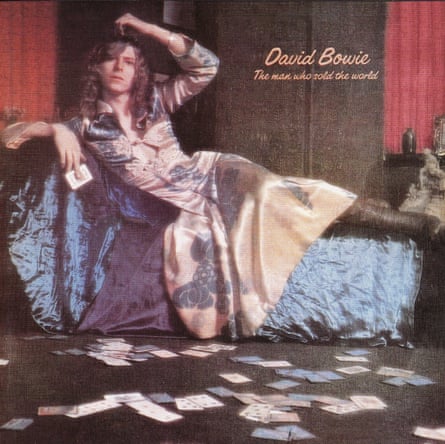
11 Bowie’s next stylistic swerve, into the glam racket of the Spiders from Mars, came about through the hasty recruitment of the Hull guitarist Mick Ronson in February 1970. Bowie and producer Tony Visconti needed a new guitarist and took on Ronson just two days before a prestigious BBC In Concert show. Ronson became Bowie’s greatest foil over the next three years as his music evolved into the full-metal outrage of Ziggy Stardust.
12 The androgynous Bowie of legend came to the fore in 1970 when he wore a flowing dress on the cover of his third album, The Man Who Sold the World, and to attendant interviews.
13 His bisexuality – both real and knowingly created through his personae – became central to his appeal to new generations of outsiders. Bowie planned the notorious Melody Maker interview of January 1972, in which he told Michael Watts “I’m gay and always have been”, as a statement of intent and a land grab for new territory of the mind.
14 By the 1971 album Hunky Dory, Bowie was writing instantly appealing pop songs that drew on dark and esoteric subjects. Oh! You Pretty Things, for instance, repackaged Aleister Crowley’s sinister occult millennialism as a bar-room singalong.
15 Bowie’s breakthrough TV appearance, performing Starman on Top of the Pops on 5 July 1972, shocked mainstream Britain with the singer’s rainbow jumpsuit and homoerotic interplay with Ronson. The fact that to many viewers he was still the Space Oddity one-hit wonder only compounded the impact, and their incredulity.
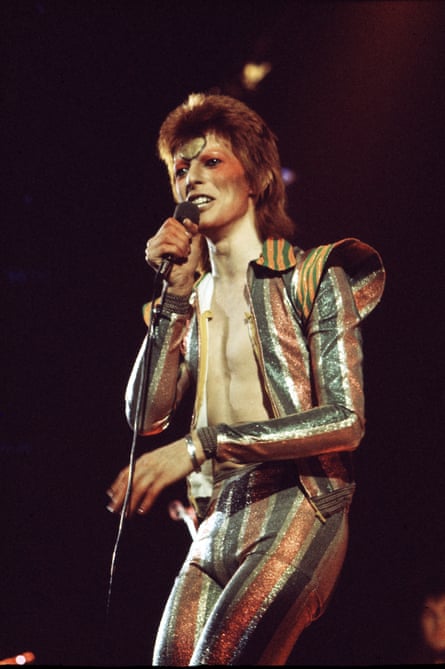
16 The song itself was a gleefully shameless cut-and-shut of Marc Bolan’s Hot Love (those na-na-nas) and that anthem of gay culture, Over the Rainbow. Bowie would occasionally intersperse lines from the latter in live performances.
17 The Rise and Fall of Ziggy Stardust and the Spiders From Mars is seen as a perfectly formed work of dystopian rock, due in no small part to the apocalyptic drama of opener Five Years. But the concept in this concept album arrived comparatively late in the recording in the form of the title track and Starman.
18 The recurring theme of mental instability in Bowie’s work connects to his half-brother Terry Burns, who was institutionalised with schizophrenia and killed himself on 16 January 1985. Bowie was accused of coldness after Burns’s death but many of his covert references – the heartfelt The Bewlay Brothers, or “I’d rather stay here with all the madmen than perish with the sad men” – could be surprisingly tender and understanding.
19 The Spiders from Mars were completely unaware that Bowie intended to kill off Ziggy live on stage at the Hammersmith Odeon on 3 July 1973. Bassist Trevor Bolder was seen to mouth the words: “He’s fucking sacked us.”
20 From Ziggy Stardust onwards, the personae that Bowie adopted to create his music began to erode the man beneath. “My alter ego wouldn’t leave me alone for years,” he later admitted. “That was when it all started to go sour.”
21 Bowie’s move to the US following Ziggy’s “death” combined an unparalleled creative explosion with equally unparalleled descent into cocaine addiction. Aided by the funk musician Carlos Alomar and a young Luther Vandross, his Young Americans album saw an unexpected diversion into R&B – his “plastic soul” period – just as Bowie became more visibly emaciated and alienated.
22 Fame, his first US No 1, came about when Bowie misheard John Lennon singing over the disco track Shame Shame Shame by Shirley & Company. A last-minute addition to the album with lyrics written in 20 minutes, it summed up Bowie’s paranoid mid-70s predicament to a prescient funk rhythm.
23 Golden Years, from Station To Station, had been intended for Elvis Presley, who rejected it.
24 Though it’s often considered to signal Bowie’s return to Europe, 1976’s turning-point album, Station to Station, was recorded in the psychic wasteland of Los Angeles, where his drug use had driven him further out than ever before. In the formless, cocaine-driven sessions, musicians were called in at any hour and told to play without songs. But the result was a masterpiece of sound-construction over songwriting.

25 The album also introduced Bowie’s most toxic alter ego, the Thin White Duke, an emotionless anorexic superman who echoed Thomas Jerome Newton, the literal alien he had played in Nic Roeg’s The Man Who Fell To Earth.
26 Famously subsisting only on cocaine, milk and red peppers, Bowie fell prey to old paranoid obsessions including UFO cover-ups, nazism and the occult while in Los Angeles. His actual – as opposed to mental – relocation to Berlin in 1976 was in part an attempt to clean up and re-evaluate.
27 It’s likely that his infamous “Nazi salute” at Victoria station on 2 May 1976 was the camera catching his waving hand at an unfortunate moment rather than a conscious Sieg Heil gesture. “I didn’t see anyone walking around saying ‘What a wanker, he gave a Nazi salute’,” recalled the young fan Gary Webb, later Gary Numan . But a morbid fascination with fascism was undeniable during Bowie’s worst cocaine years. In 1974 he had told Playboy that “Adolf Hitler was one of the first rock stars.”
28 The move to Berlin was life-changing for Bowie. Cutting down on the drugs, he developed an interest in German art and worked prolifically with Visconti and Brian Eno , producing his own Berlin Trilogy (Low, Heroes and Lodger) plus flatmate and fellow recoveree Iggy Pop’s The Idiot and Lust For Life.
29 Though formally austere, the minimalist, often instrumental Low and the heavier, fuller Heroes albums were life-affirming and full of new directions – and portents of the new wave that would follow punk. Yet Bowie’s label RCA had attempted to dismiss Low, asking for Young Americans 2 instead.
30 The only one of the Berlin Trilogy to be fully recorded in the city, Heroes captured a time and space in history – West Berlin, the hinge of the cold war – as few rock records ever have. Recorded at Hansa Studios within sight of the Berlin Wall, the record celebrates both doomed, stolen moments of individual freedom, with its images of producer Tony Visconti and his girlfriend kissing by the wall, and the visions of the uncontrollable imagination.
31 Titled with quotation marks to denote the irony of declaring yourself a hero, the song “Heroes” gets its emotional intensity from Visconti’s arrangement. Here Robert Fripp’s guitars and Brian Eno’s electronics rise until Bowie’s voice is fighting against the music – a lone individual against the elements.
32 By 1980, Bowie’s legacy was sufficiently rich that he could call upon his followers for inspiration. For the album Scary Monsters it was the new romantics of London clubland who had turned Bowie’s post-gender self-reinvention into a design for life. The most expensive pop video made to that date – it cost £25,000 – the Ashes to Ashes clip featured Bowie as Pierrot, Major Tom in an HR Giger-style torture chamber and Blitz Kid extras including Steve Strange. “My robe kept catching on the bulldozer,” Strange recalled.
33 Critics have often described Bowie’s acting career as patchy, perhaps because his best achievements are not preserved. His 1980 US stage role as John Merrick in The Elephant Man revealed genuine ability – “his talent was bigger than his ego, which is rare,” said co-star Jeanette Landis – and his well-reviewed starring role in a BBC adaptation of Bertolt Brecht’s Baal survives on YouTube.
34 Under Pressure, his collaboration with Queen , bridges the Art Bowie of the 70s and Commercial Bowie of the 80s – yet at first both parties were unsure whether to release it. “To have his ego mixed with ours was a very volatile mixture,” recalled the Queen guitarist Brian May.
35 Often seen as the beginning of mainstream Bowie, and thus his creative decline, the 1983 album Let’s Dance was planned as a return to the 50s R&B that Bowie had first fallen in love with. Instead it became a heavy-duty 80s dance record and globally his most successful release.
36 Let’s Dance began with another surprise firing of an entire creative team. Visconti waited by the phone for two weeks before discovering that Bowie had recruited Chic’s Nile Rodgers to produce with the unBowielike instruction: “Nile, I really want you to make hits.”
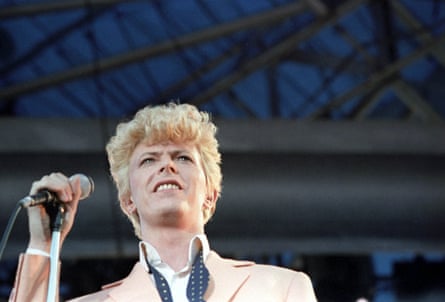
37 Much derided by those who confuse it with the pretentious bafflement of his subsequent Glass Spider tour, Bowie’s 96-date Serious Moonlight stadium tour in 1983 was hugely acclaimed at the time. It also saw a surprise one-night return by Mick Ronson in Toronto in September.
38 Bowie barely received any direction for his second-most acclaimed acting role, that of Celliers in Merry Christmas Mr Lawrence. Director Nagisa Oshima told his British cast to “do whatever it is that you people do”.
39 The index of Bowie’s creative blockage in the 80s was his lack of new songs. Three of Let’s Dance’s eight tracks were old songs or covers; its disastrous follow-up Tonight was more than 50% ballast. Yet even this, many people’s worst Bowie record, contained a classic: Loving the Alien.
40 See also Absolute Beginners from the largely forgettable film of the same name. Bowie’s last classic of the 1980s was written and recorded in one afternoon with a makeshift band.
41 Bowie had been scheduled to perform Five Years at Live Aid . He dropped the song to allow the BBC to broadcast the famous video of the Ethiopian famine, generating a spike in donations.
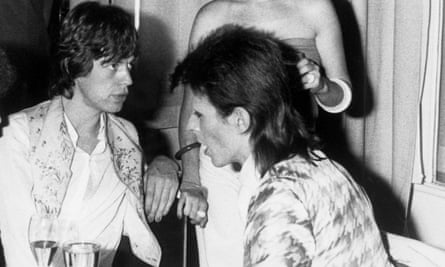
42 Bowie teamed up with Mick Jagger for the widely derided Dancing in the Street in 1985 to raise money for Live Aid. The song topped the UK charts for four weeks. In 2011, a survey found it was the song Britons most wanted played at street parties to celebrate the wedding of Prince William to Kate Middleton.
43 Though much mocked at their inception in 1989, Bowie’s deliberately basic, Pixies-inspired four-piece rock band, Tin Machine, at least attempted to anticipate grunge – and gave Bowie one of his lasting collaborators in the form of guitarist Reeves Gabrels.
44 In 1997 he sold $55m (£33m) worth of Bowie Bonds, securitising the future earnings of his 25 pre-1990 albums. The collapse in the value of copyrights after the advent of the Napster file-sharing service drove Bowie Bonds to junk status.
45 In 2001 Bowie recorded a complete album of reworked old songs and new compositions inspired by his youth. Entitled Toy – possibly after the pejorative term for a johnny-come-lately mod – it remains unreleased.
46 His disappearance from public view following his heart attack in 2004 began the most affecting vanishing act in rock history. His final live show was a 2006 charity event where he performed Fantastic Voyage, Wild is the Wind and Changes as a duet with Alicia Keys .
47 Bowie’s stock rose hugely in his absence, making a global news event of his surprise return with The Next Day in 2013. The Victoria and Albert Museum’s retrospective exhibition that same year, David Bowie Is…, became its fastest-selling event ever. The first track to be released from the album – Where Are We Now? – appeared to spring from an appearance in Ricky Gervais’s sitcom Extras in 2006.
49 Though he accepted a Commandeur de l’Ordre des Arts et des Lettres from the French government, Bowie turned down a CBE in 2000, and a knighthood in 2003 with the words: “I seriously don’t know what it’s for.”
49 His final album is – as we all now realise – shot through with intimations of mortality, including Lazarus’s kabbalistic image of the spirit rising and the promo photos with buttons/coins on Bowie’s eyes. The title of the final track sums up his entire career: I Can’t Give Everything Away.
50 In early January 2016, Brian Eno received an email from Bowie. It read “Thank you for our good times, Brian. They will never rot,” and was signed “Dawn”. “I realise now,” Eno wrote, “that he was saying goodbye.”
- David Bowie
- Pop and rock
- Nile Rodgers
- Bertolt Brecht

Let's dance: unseen images of David Bowie on tour in 1983

David Bowie honoured with three blue plaques on BBC Music Day

Worldwide tributes to David Bowie: 'His death was a work of art'


David Bowie: the man who thrilled the world

David Bowie dies of cancer at 69: 'He gave us magic for a lifetime'

David Bowie’s style legacy: ‘He stole ideas from everywhere’

Bowie in America: how the US got under the singer's skin, and vice versa

David Bowie obituary
Most viewed.
- Statistics Stats
- You are here:
- Bowie, David
- July 1, 1983 Setlist
David Bowie Setlist at Milton Keynes National Bowl, Milton Keynes, England
- Edit setlist songs
- Edit venue & date
- Edit set times
- Add to festival
- Report setlist
Tour: Serious Moonlight Tour statistics Add setlist
- The Jean Genie ( alternative version - snippet ) Play Video
- Star Play Video
- "Heroes" Play Video
- What in the World Play Video
- Golden Years Play Video
- Fashion Play Video
- Let's Dance Play Video
- Breaking Glass Play Video
- Life on Mars? Play Video
- Sorrow ( The McCoys cover) Play Video
- Cat People (Putting Out Fire) Play Video
- China Girl ( Iggy Pop cover) Play Video
- Scary Monsters (and Super Creeps) Play Video
- Rebel Rebel Play Video
- White Light/White Heat ( The Velvet Underground cover) Play Video
- Station to Station Play Video
- Cracked Actor Play Video
- Ashes to Ashes Play Video
- Space Oddity Play Video
- Young Americans Play Video
- TVC15 Play Video
- Fame Play Video
- Stay Play Video
- The Jean Genie Play Video
- Modern Love Play Video
Edits and Comments
16 activities (last edit by ndharris1 , 24 Jul 2020, 16:33 Etc/UTC )
Songs on Albums
- Golden Years
- Station to Station
- The Jean Genie (2)
- Cracked Actor
- Cat People (Putting Out Fire)
- Let's Dance
- Modern Love
- Ashes to Ashes
- Scary Monsters (and Super Creeps)
- China Girl by Iggy Pop
- Sorrow by The McCoys
- White Light/White Heat by The Velvet Underground
- Breaking Glass
- What in the World
- Young Americans
- "Heroes"
- Space Oddity
- Rebel Rebel
- Life on Mars?
Complete Album stats
More from David Bowie
- More Setlists
- Artist Statistics
- Add setlist
Related News
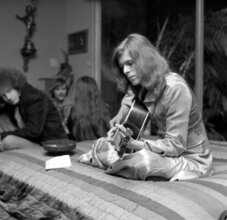
David Bowie Played a London Speakeasy for His 23rd Birthday
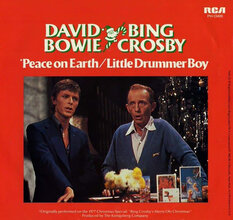
Today in 1977 David Bowie & Bing Crosby Sang Christmas Songs
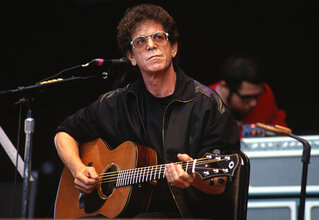
On This Day in 1997: Friends of Lou Reed Make Perfect Day '97
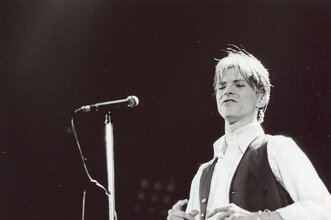
Setlist History: In 1971 David Bowie Debuted 'Changes' at 5am
Milton keynes national bowl.
- David Bowie This Setlist Add time Add time
- Icehouse Add time Add time
- The Beat Add time Add time
David Bowie Gig Timeline
- Jun 28 1983 Murrayfield Stadium Edinburgh, Scotland Add time Add time
- Jun 30 1983 Hammersmith Odeon London, England Add time Add time
- Jul 01 1983 Milton Keynes National Bowl This Setlist Milton Keynes, England Add time Add time
- Jul 02 1983 Milton Keynes National Bowl Milton Keynes, England Add time Add time
- Jul 03 1983 Milton Keynes National Bowl Milton Keynes, England Add time Add time
42 people were there
- asdarkasblack
- Chuckronson
- Collegeranger
- Foolonthehill
- GeordieBlue
- hammersfan108
- ironmammoth
- MutinyInHeaven
- petemarchant55
- PeterWanless
- Rob_Bending
- robertwiltsher
- stevemarchant
Share or embed this setlist
Use this setlist for your event review and get all updates automatically!
<div style="text-align: center;" class="setlistImage"><a href="https://www.setlist.fm/setlist/david-bowie/1983/milton-keynes-national-bowl-milton-keynes-england-3d0e9a7.html" title="David Bowie Setlist Milton Keynes National Bowl, Milton Keynes, England 1983, Serious Moonlight" target="_blank"><img src="https://www.setlist.fm/widgets/setlist-image-v1?id=3d0e9a7" alt="David Bowie Setlist Milton Keynes National Bowl, Milton Keynes, England 1983, Serious Moonlight" style="border: 0;" /></a> <div><a href="https://www.setlist.fm/edit?setlist=3d0e9a7&step=song">Edit this setlist</a> | <a href="https://www.setlist.fm/setlists/david-bowie-6bd6ee66.html">More David Bowie setlists</a></div></div>
Last.fm Event Review
[url=https://www.setlist.fm/setlist/david-bowie/1983/milton-keynes-national-bowl-milton-keynes-england-3d0e9a7.html][img]https://www.setlist.fm/widgets/setlist-image-v1?id=3d0e9a7[/img][/url] [url=https://www.setlist.fm/edit?setlist=3d0e9a7&step=song]Edit this setlist[/url] | [url=https://www.setlist.fm/setlists/david-bowie-6bd6ee66.html]More David Bowie setlists[/url]
Tour Update
Marquee memories: jesse mccartney.
- Jesse McCartney
- Apr 11, 2024
- Apr 10, 2024
- Apr 9, 2024
- Apr 8, 2024
- Apr 7, 2024
- Apr 6, 2024
- FAQ | Help | About
- Terms of Service
- Ad Choices | Privacy Policy
- Feature requests
- Songtexte.com
- Serious Moonlight Tour
Live: National Bowl, Milton Keynes
David Bowie performed at the Milton Keynes National Bowl on 1 July 1983, as part of the Serious Moonlight Tour.
It was the 28th date of the tour, which began on 18 May in Brussels .
Bowie’s guitarists were Carlos Alomar and Earl Slick. Dave Lebolt was on keyboards and synthesizers, and Steve Elson, Stan Harrison, Lenny Pickett played saxophones. Carmine Rojas played bass guitar and Tony Thompson was on drums and percussion. George and Frank Simms were the backing singers.
This was the first of three consecutive night at the Milton Keynes National Bowl. Bowie returned to the venue on 4 and 5 August 1990 during the Sound+Vision Tour.
The setlist
- ‘What In The World’
- ‘Golden Years’
- ‘Let’s Dance’
- ‘Breaking Glass’
- ‘Life On Mars?’
- ‘Cat People (Putting Out Fire)’
- ‘China Girl’
- ‘Scary Monsters (And Super Creeps)’
- ‘Rebel Rebel’
- ‘White Light/White Heat’
- ‘Station To Station’
- ‘Cracked Actor’
- ‘Ashes To Ashes’
- ‘Space Oddity’
- ‘Young Americans’
- ‘The Jean Genie’
- ‘Modern Love’
Also on this day...
- 2002: Live: Olympia, Paris
- 1997: Dom Sportova, Zagreb
- 1996: Live: Rockin’ Athens festival
- 1989: Live: Tin Machine, Newport Leisure Centre, Newport
- 1987: Live: Praterstadion, Vienna
- 1978: Live: Earls Court, London
- 1974: Live: Fox Theatre, Atlanta
- 1972: Live: Winter Gardens Pavilion, Weston-super-Mare
Want more? Visit the David Bowie history section .
Leave a Reply

IMAGES
VIDEO
COMMENTS
More than 150,000 descended on the National Bowl in Milton Keynes that sweltering weekend in July 1983, on a tour that saw Bowie play his first live gigs in England in five years. I was among them.
The Serious Moonlight Tour was a worldwide concert tour by the English musician David Bowie, launched in May 1983 in support of his album Let's Dance (1983). The tour opened at the Vorst Forest Nationaal, Brussels, on 18 May 1983 and ended in the Hong Kong Coliseum on 8 December 1983; 15 countries visited, 96 performances, and over 2.6 million tickets sold.
Get the David Bowie Setlist of the concert at Milton Keynes National Bowl, Milton Keynes, England on July 3, 1983 from the Serious Moonlight Tour and other David Bowie Setlists for free on setlist.fm!
The David Bowie Serious Moonlight Tour was thus far Bowie's longest, largest and most successful concert tour. The tour opened at the Vorst Forest Nationaal, Brussels, on 18 May 1983 and ended in the Hong Kong Coliseum on 8 December 1983; 16 countries visited, 96 performances, and over 2.6M tickets sold. The tour garnered mostly favorable ...
David Bowie, The English Beat, & Icehouse info along with concert photos, videos, setlists, and more. ... Login; Sign Up (it's free!) Home; Concerts; David Bowie / The English Beat / Icehouse. Let's Dance Jul 2, 1983 (41 years ago) Milton Keynes Bowl Milton Keynes, England, United Kingdom. Scroll to: Scroll to: Top; Bands; Details; Details ...
David Bowie performed at the Milton Keynes National Bowl on 2 July 1983, as part of the Serious Moonlight Tour. It was the 29th date of the tour, which began on 18 May in Brussels. Bowie's guitarists were Carlos Alomar and Earl Slick. Dave Lebolt was on keyboards and synthesizers, and Steve Elson, Stan Harrison, Lenny Pickett played saxophones.
The unique singer was performing songs on his Sound+Vision tour, the gig on August 5 1990 was the second of two shows in Milton Keynes. The Bowl was the first leg of his return to Europe after a three-month voyage performing across North America. Reports from the gig over 30 years ago suggest Bowie performed in front of a whopping 60,000-plus ...
David Bowie 1983 07 01 Concert Bowl, Milton Keynes UKSetlistIntroJean Genie - StarLavender Blue - HeroesWhat In The WorldGolden Years FashionLets DanceBre...
David Bowie performs at Milton Keynes Bowl on July 2, 1983. ... Vaughan served as the lead guitarist on David Bowie's 1983 smash LP Let's Dance. ... the Serious Moonlight tour in support of ...
David Bowie - Serious Moonlight 1983 World Tour. More images. Label:Diamond Doghouse Recordings - DDH83: ... Live At Milton Keynes National Bowl, Milton Keynes, England, July 1 1983 - Part 1 ... Let's Dance: 9-9: Breaking Glass: 9-10: Life On Mars? 9-11: Sorrow: 9-12: Cat People (Putting Out Fire) 9-13: China Girl:
Monday 11 January 2016, 1:10pm. David Bowie in concert at Milton Keynes Bowl in August 1990. Credit: ITV Anglia. It was a hot summer's day back in 1990 that a crowd of 60,000 gathered at the ...
The year was 1983, and Bowie was riding the wave of his critically acclaimed album, "Let's Dance," which had catapulted him back into the mainstream music scene. The Milton Keynes Bowl, known for its capacity to host large-scale events, was chosen as the venue for Bowie's highly anticipated performance on July 30.
David Bowie performing his hit single "Let's Dance" in 1983 during Serious Moonlight Tour.
David Bowie plays the Milton Keynes Bowl in 1983 on the Serious Moonlight Tour. ... Bowie's 96-date Serious Moonlight stadium tour in 1983 was hugely acclaimed at the time. It also saw a ...
Audio recording of the Radio 1 broadcast of David Bowie's Sound and Vision tour concert at Milton Keynes Bowl on the 5th of August 1990.
'˜Bowie Experience '" The Golden Years Tour' - a concert celebrating the music of the world's greatest pop icon David Bowie, will be visiting Milton Keynes Theatre next month. News you can trust since 1981. Aldi raises workers' wages to become the best-paid supermarket in Milton Keynes.
Live bootleg from a BBC Radio 1 radio broadcast, recorded August 5, 1990 at Milton Keynes Bowl. This is the original French pressing with yellow (disc 1) and white (disc 2) print on discs. Track durations above not mentioned on CDs or sleeve, but taken from a media player. CDs are housed in a big jewel case.
Get the David Bowie Setlist of the concert at Milton Keynes National Bowl, Milton Keynes, England on July 1, 1983 from the Serious Moonlight Tour and other David Bowie Setlists for free on setlist.fm!
David Bowie performed at the Milton Keynes National Bowl on 1 July 1983, as part of the Serious Moonlight Tour. It was the 28th date of the tour, which began on 18 May in Brussels. Bowie's guitarists were Carlos Alomar and Earl Slick. Dave Lebolt was on keyboards and synthesizers, and Steve Elson, Stan Harrison, Lenny Pickett played saxophones.
'˜Bowie Experience '" The Golden Years Tour' - a concert celebrating the music of the world's greatest pop icon David Bowie, will be visiting Milton Keynes Theatre next month. News you can trust since 1981. NationalWorldTV. Man arrested on suspicion of drink driving after woman left with broken hand in Milton Keynes crash.
Tickets available from £26.50. subject to a transaction fee of £3.95. Tribute. 2 hours 30 minutes. incl. interval. Play the full trailer. Buy Tickets. scroll down. Direct from London's West End, Bowie Experience is a spectacular concert celebrating the music of the world's greatest pop icon, David Bowie.
Complete BBC Radio 1 radio broadcast of the second Milton Keynes Bowl concert on August 5, 1990. 4 page booklet included. The original release of David Bowie - Milton Keynes Live is in fact a French pressing, using fake catalogue numbers of the Japanese BOW label. No Japanese pressing of this release does exist, not by BOW or any other label.